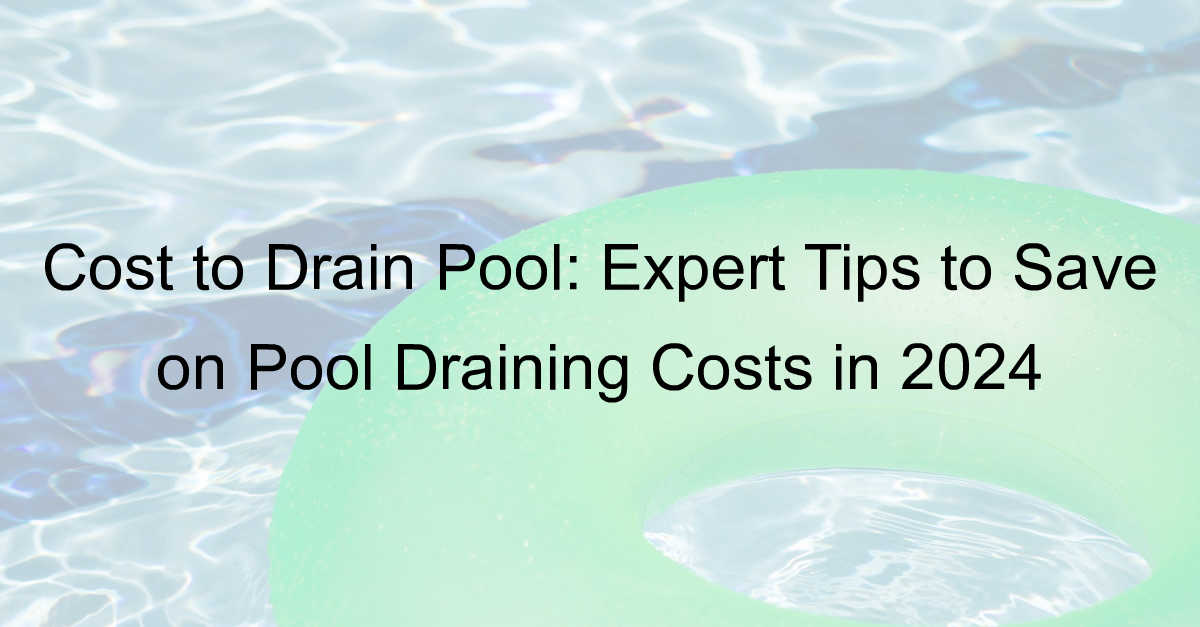Table of Contents
Draining a pool is an essential task that many homeowners face, yet the associated expenses can often come as a surprise. In 2024, understanding the cost to drain pool can help you make informed decisions. By adopting expert advice, you can minimize these costs and ensure your pool remains in good condition. After all, a well-maintained pool enhances the beauty of your home and provides enjoyment for years to come.
Main Points
- Understand the factors influencing the cost to drain pool.
- Explore cost-saving tips provided by experts.
- Learn when it’s necessary to drain your pool.
Understanding the Factors Influencing Pool Draining Costs in 2024
Draining a pool might seem like a simple task, but various elements can impact the cost involved. As we step into 2024, understanding these factors becomes essential for homeowners looking to maintain their pools efficiently.
Key Influencing Factors
- Pool Size: Larger pools require more time and resources to drain, which can elevate costs significantly.
- Water Disposal Method: Depending on local regulations, choosing between options like municipal drainage or on-site filtration can affect expenses.
- Labor Costs: The expertise and rates of professionals in your area can add to the overall cost structure.
Moreover, factors like accessibility, the type of pool materials, and any necessary repairs post-drainage could lead to unexpected expenses. Therefore, it’s crucial to plan ahead and possibly get multiple quotes to ensure you’re not caught off guard. Many homeowners often overlook these intricacies, leading to confusion and, unfortunately, inflated budgets.
Ultimately, a well-informed approach ensures a smooth draining process without the embedded costs creeping up on you.
Cost-Saving Strategies: How to Reduce Your Pool Draining Expenses
Maintaining a pool can indeed be a delightful experience, but it doesn’t come without its costs. If you find yourself grappling with rising expenses related to pool draining and maintenance, fear not; there are effective strategies you can implement.
Assess Water Quality Regularly
First and foremost, regularly checking your water quality can extend the life of your pool’s water. This means fewer drainings. Test and treat the water to maintain proper chemical balance. Doing so not only enhances the swimming experience but also saves you money.
Optimize Your Filtration System
It’s vital to invest in a good filtration system. Ensure it runs efficiently to eliminate the need for frequent draining. When debris build-up occurs, clean it promptly—this little effort goes a long way!
Consider Seasonal Maintenance
Finally, plan your drainings strategically. For example, it might not be necessary to drain your pool during off-seasons. Think ahead, and you’ll keep that wallet a bit heavier.
| Strategy | Potential Savings |
|---|---|
| Regular Water Testing | Up to 30% |
| Efficient Filtration | Up to 50% |
| Seasonal Drain Planning | Up to 20% |
Implementing these strategies can cultivate not just enjoyment but also a healthier financial outlook. It’s a win-win!
DIY vs. Professional Pool Draining: Which Option is More Cost-Effective?
When contemplating whether to drain your pool yourself or hire a professional, the cost-effectiveness of each option often comes to the forefront. On one hand, a DIY approach may seem appealing. You save money on labor, and you have complete control over the process. However, there are significant factors that could lead to unexpected expenses.
For instance, incorrect draining techniques can result in structural damage to your pool, leading to expensive repairs. Conversely, hiring a professional may initially appear more costly, but it often guarantees optimal safety and quality. Professionals use specialized equipment and expertise that a typical homeowner may lack. This could potentially save you money in the long run.
Considering Long-Term Costs
Moreover, think about the time you invest in a DIY project. Time is a valuable resource. If the process consumes your weekends or disrupts your schedule, perhaps hiring a professional becomes more appealing. In essence, while the immediate costs are crucial, don’t overlook the long-term ramifications of your choice. Ultimately, weigh the risks and potential future expenses before making a decision.
Conclusion
In conclusion, maintaining a pool can sometimes feel overwhelming, especially when considering the various costs involved. One significant expense that often catches homeowners off guard is the cost to drain a pool. It’s essential to plan for this when budgeting for pool maintenance. However, don’t let the potential costs deter you from enjoying the benefits of your pool. Taking proper care and considering all aspects, including draining it when necessary, can lead to a more enjoyable experience in the long run. Therefore, stay informed about the needs of your pool, and you’ll find that the joy it brings far outweighs the upkeep responsibilities.
Frequently Asked Questions
How much does it typically cost to drain a swimming pool?
The cost to drain a swimming pool can vary widely depending on the size of the pool, the method used for draining, and your location. On average, it could range from $150 to $500.
Are there additional costs I should be aware of when draining a pool?
Yes, additional costs may include water disposal fees, refilling the pool with water, and any necessary maintenance or repairs that may be needed after the drainage.
Is it necessary to drain my pool completely for maintenance?
Not always. Many maintenance tasks can be performed without draining the pool completely. However, in cases of extensive cleaning or repairs, total drainage may be required.
